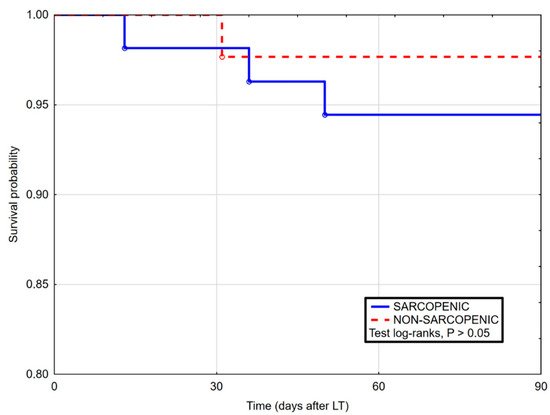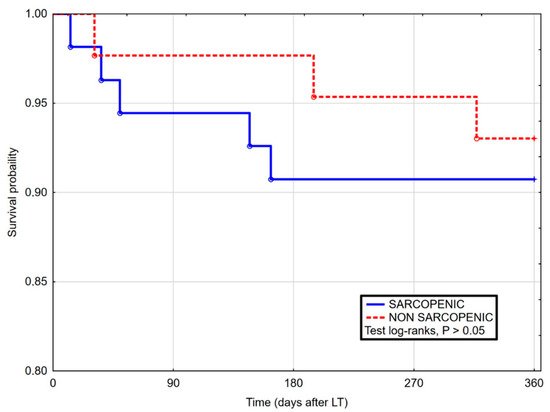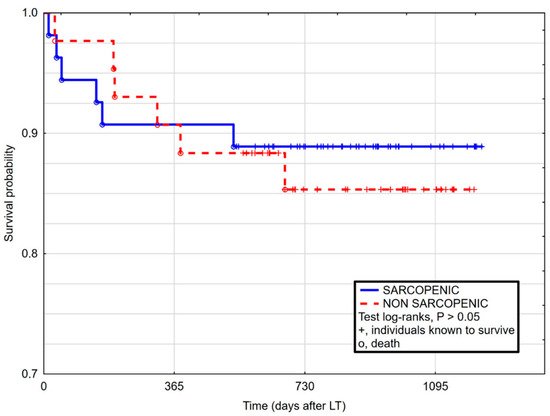Optimizing patients’ condition before liver transplantation (LT) could potentially improve survival of LT patients. We focused on sarcopenia, as a common factor in liver transplant candidates that can impact their cardiopulmonary performance at the point of listing, morbidity, and mortality after LT. We performed a single-center cohort study on 98 consecutive patients with liver cirrhosis who were transplanted between March 2015 and December 2017. The third lumbar vertebra skeletal muscle index (L3SMI) was calculated using CT imaging to distinguish sarcopenia at listing for LT. Data regarding liver function, body mass index (BMI), cardiac biomarkers, the peak oxygen uptake (VO2) and LT outcome were collected and correlated to L3SMI. For data analysis the Dell Statistica (Version 13. Dell Inc., Rondrock, TX, USA) was used. In total, 98 cirrhotic patients were included. Fifty-five (56.1%) patients, mostly males, had sarcopenia according to L3SMI, with the lowest L3SMI in males with alcohol-related liver disease. Lower L3SMI correlated with lower BMI, lower VO2 peak, and higher NTproBNP (all p < 0.001) and revealed an essential correlation with prolonged ICU stay (r = −0.21, p < 0.05). 33 patients were unable to perform cardio-pulmonary exercise test, mostly sarcopenic (67%), with more advanced liver insufficiency (assessed with CPC and MELD scores) and longer stay at ICU after LT (all p < 0.001). Sarcopenia was common among LT recipients. It was associated with inferior result in cardio-pulmonary performance before LT and prolonged ICU stay after grafting.
- sarcopenia
- end-stage liver disease
- liver transplantation
- cardio-pulmonary performance
- L3SMI
1. Introduction
2. Analysis on Results
| Sarcopenic (n = 55) |
Non-Sarcopenic (n = 43) |
p Value |
|---|
| L3 SMI | VO2 Peak (J. Eq.) |
TnI | NT-proBNP |
|---|
| Age | 55 (9) | 57 (9) | 0.244 |
| L3SMI | 0.592 ** | −0.095 | −0.531 ** | |
| Gender (female) | 20% | |||
| VO2 | ||||
| 28% | ||||
| Peak (J. eq.) | 0.592 ** | |||
| 0.364 | ||||
| −0.098 | −0.354 | |||
| Etiology HCV HCC ALD |
29% 20% 51% |
32.5% 35% 32.5% |
||
| TnI | −0.095 | −0.098 | ||
| 0.716 | 0.100 0.071 |
|||
| 0.107 | ||||
| BMI (kg/m2) | 24.8 (5) | 29.3 (5) | ||
| NT-proBNP | ||||
| <0.001 | ||||
| −0.531 ** | −0.354 | 0.107 | ||
| MELD (points) | 18 (14) | 16 (11) | 0.161 | |
| BMI | 0.473 ** | 0.485 ** | 0.197 | −0.056 |
| CPC (points) | 10 (3) | 9 (4) | 0.289 | |
| MELD | −0.159 | −0.151 | 0.380 * | |
| VO2 Peak (J. eq.) | 63.2 (33) | 79.3 (29) | 0.064 | |
| 0.266 | ||||
| CPC | −0.159 | −0.142 | ||
| TnI | 0.009 (0.02) | 0.010 (0.03) | 0.988 | |
| NT-proBNP | 176 (263) | 74 (79) | 0.043 |
| 0.344 * | |||
| 0.088 | |||
| ICU Stay | |||
| −0.208 * | −0.217 | 0.087 | 0.358 * |



